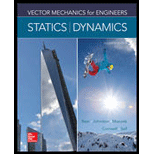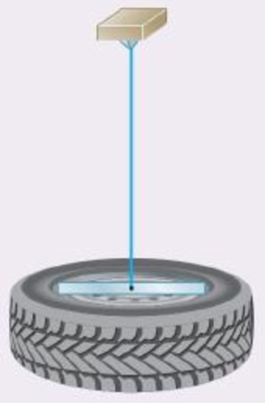
Concept explainers
An automobile wheel-and-tire assembly of total weight 47 lb is attached to a mounting plate of negligible weight that is suspended from a steel wire. The torsional spring constant of the wire is known to be K = 0.40 lb·in/rad. The wheel is rotated through 90° about the vertical and then released. Knowing that the period of oscillation is observed to be 30 s, determine the centroidal mass moment of inertia and the centroidal radius of gyration of the wheel-and-tire assembly.

Fig. P19.159
The centroidal mass moment of inertia
Answer to Problem 19.159RP
The centroidal mass moment of inertia
Explanation of Solution
Given information:
The total weight of the automobile (W) is 47 lb.
The total spring constant of wire (K) is
The wheel rotates at an angle
The time period of oscillation
The acceleration due to gravity (g) is
Calculation:
Calculate the frequency of oscillation (f) using the formula:
Substitute 30 s for
Calculate the natural circular frequency of oscillation
Substitute 0.03333 Hz for f.
When an angular displacement of
Take moment for external forces as follows:
Here,
Restoring couple acts on the system due to the angular displacement of
Take moment for effective forces as follows;
Here,
Equate the moment for external and effective forces in the system using the relation:
The expression for the general differential equation of motion as follows:
Find the expression for the natural circular frequency of vibration:
Compare the differential equations (1) and (2).
Substitute
The expression for the centroidal mass moment of inertia as follows:
Here, m is the mass of the wheel-and-tire assembly and
Calculate the mass of the wheel-and-tire assembly (m) using the formula:
Substitute 47 lb for W and
Substitute
Therefore, the centroidal mass moment of inertia
Want to see more full solutions like this?
Chapter 19 Solutions
Vector Mechanics for Engineers: Statics and Dynamics
- Auto Controls Hand sketch the root Focus of the following transfer function How many asymptotes are there ?what are the angles of the asymptotes?Does the system remain stable for all values of K NO COPIED SOLUTIONSarrow_forward-400" 150" in Datum 80" 90" -280"arrow_forwardUsing hand drawing both of themarrow_forward
- A 10-kg box is pulled along P,Na rough surface by a force P, as shown in thefigure. The pulling force linearly increaseswith time, while the particle is motionless att = 0s untilit reaches a maximum force of100 Nattimet = 4s. If the ground has staticand kinetic friction coefficients of u, = 0.6 andHU, = 0.4 respectively, determine the velocityof the A 1 0 - kg box is pulled along P , N a rough surface by a force P , as shown in the figure. The pulling force linearly increases with time, while the particle is motionless at t = 0 s untilit reaches a maximum force of 1 0 0 Nattimet = 4 s . If the ground has static and kinetic friction coefficients of u , = 0 . 6 and HU , = 0 . 4 respectively, determine the velocity of the particle att = 4 s .arrow_forwardCalculate the speed of the driven member with the following conditions: Diameter of the motor pulley: 4 in Diameter of the driven pulley: 12 in Speed of the motor pulley: 1800 rpmarrow_forward4. In the figure, shaft A made of AISI 1010 hot-rolled steel, is welded to a fixed support and is subjected to loading by equal and opposite Forces F via shaft B. Stress concentration factors K₁ (1.7) and Kts (1.6) are induced by the 3mm fillet. Notch sensitivities are q₁=0.9 and qts=1. The length of shaft A from the fixed support to the connection at shaft B is 1m. The load F cycles from 0.5 to 2kN and a static load P is 100N. For shaft A, find the factor of safety (for infinite life) using the modified Goodman fatigue failure criterion. 3 mm fillet Shaft A 20 mm 25 mm Shaft B 25 mmarrow_forward
 Elements Of ElectromagneticsMechanical EngineeringISBN:9780190698614Author:Sadiku, Matthew N. O.Publisher:Oxford University Press
Elements Of ElectromagneticsMechanical EngineeringISBN:9780190698614Author:Sadiku, Matthew N. O.Publisher:Oxford University Press Mechanics of Materials (10th Edition)Mechanical EngineeringISBN:9780134319650Author:Russell C. HibbelerPublisher:PEARSON
Mechanics of Materials (10th Edition)Mechanical EngineeringISBN:9780134319650Author:Russell C. HibbelerPublisher:PEARSON Thermodynamics: An Engineering ApproachMechanical EngineeringISBN:9781259822674Author:Yunus A. Cengel Dr., Michael A. BolesPublisher:McGraw-Hill Education
Thermodynamics: An Engineering ApproachMechanical EngineeringISBN:9781259822674Author:Yunus A. Cengel Dr., Michael A. BolesPublisher:McGraw-Hill Education Control Systems EngineeringMechanical EngineeringISBN:9781118170519Author:Norman S. NisePublisher:WILEY
Control Systems EngineeringMechanical EngineeringISBN:9781118170519Author:Norman S. NisePublisher:WILEY Mechanics of Materials (MindTap Course List)Mechanical EngineeringISBN:9781337093347Author:Barry J. Goodno, James M. GerePublisher:Cengage Learning
Mechanics of Materials (MindTap Course List)Mechanical EngineeringISBN:9781337093347Author:Barry J. Goodno, James M. GerePublisher:Cengage Learning Engineering Mechanics: StaticsMechanical EngineeringISBN:9781118807330Author:James L. Meriam, L. G. Kraige, J. N. BoltonPublisher:WILEY
Engineering Mechanics: StaticsMechanical EngineeringISBN:9781118807330Author:James L. Meriam, L. G. Kraige, J. N. BoltonPublisher:WILEY





